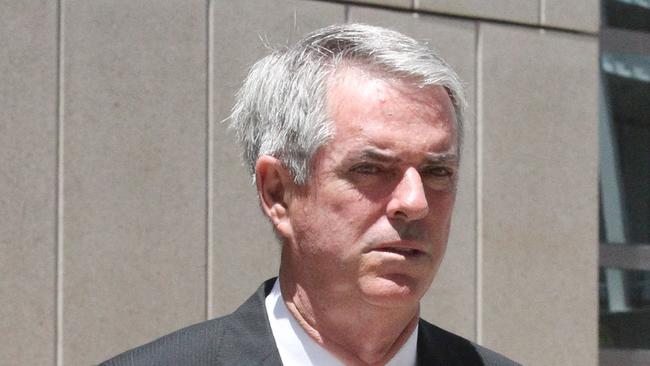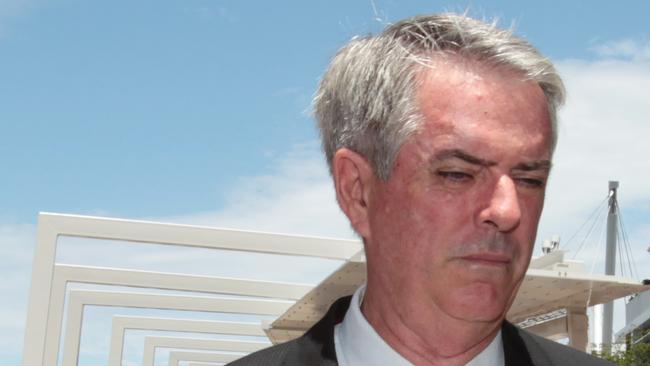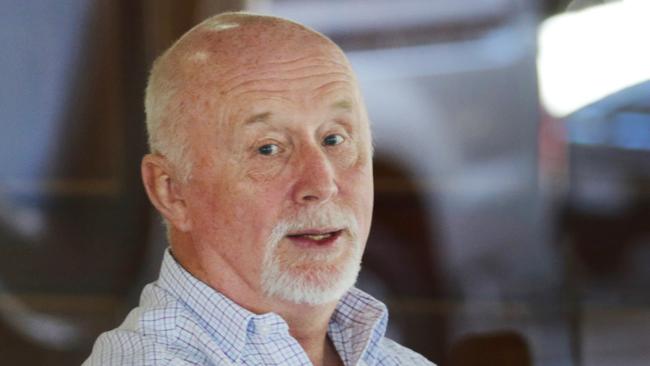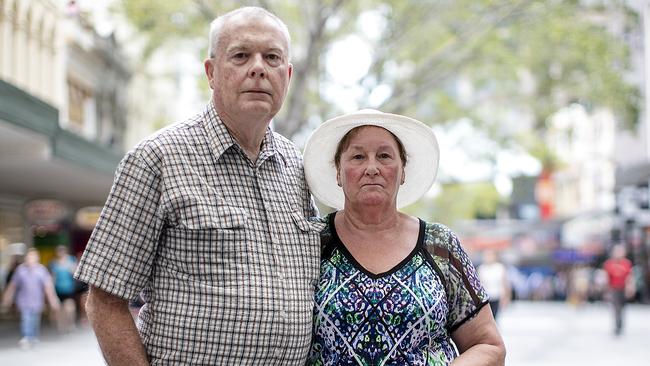How Brad Sherwin scammed investors in $60 million Ponzi scheme
BOB Spence sliced a muffin in two, and as he went to put butter on the knife, could only think about sticking the blade into the neck of the financial planner sitting across from him. Losing more than $800,000 will do that to a man.

QBM
Don't miss out on the headlines from QBM. Followed categories will be added to My News.
BOB Spence sliced a muffin in two, and as he went to put butter on the knife, could only think about sticking the blade into the neck of the financial planner sitting across a small table from him.
A loss of more than $800,000 will do that to a man. Spence had spent years working two jobs to fund a comfortable retirement or take care of his wife if something went bad. Now this Queensland financial planner Brad Sherwin had ripped him off.
Even worse, they had known each other for decades. They had worked together. They had gone to State of Origin matches together.
Now Sherwin was sitting at a coffee shop, blaming everyone under the sun except himself for $60 million in investor funds going up in smoke.
But killing is a terrifying notion, even if it is something Spence would never actually do. “I was that close to sticking that knife in his f---ing neck. That close. Serious. I had nightmares for months after it,” Spence says.

It is one of many nightmares inflicted on almost 400 victims since Sherwin’s companies collapsed five years ago. The calamity had bigger ramifications, staining the emerging self-managed superannuation fund (SMSF) sector, which Australian Taxation Office statistics show is used by almost 1.1 million people.
Perhaps some victims’ pain eased this month when Sherwin was jailed for 10 years for fraud in Brisbane’s District Court.
Perhaps the damage is too raw. There are retirees starting new jobs, victims stripped of their ability to trust and even children of one client spending $50,000 to sort out their mum’s financial mess.
Problems plague big institutions, too. The Courier-Mail can reveal complaints have been made to the legal watchdog about a law firm and its Sherwin-related property deals.
It’s a messy result for a financial planning outfit operated by a man who nurtured clients’ trust for decades. And then betrayed them.

BLESSED START
Bradley Thomas Sherwin should not have finished like this. He was born in Brisbane in 1954 to Mavis and Tom, a lovely man in publishing at evening newspaper The Telegraph, where Brad worked part-time while studying (some co-workers would unfortunately become future clients).
The work, at the same Brisbane office where The Courier-Mail was published, involved loading 15kg stacks of publications into delivery trucks. Spence was there. He recalls Sherwin as a typical university student, chasing women and grog.
“But he used to keep up with us working. He never slacked off. He never used his father’s position to get an easy job ,” Spence says.
Sherwin was also “academically smart”, says a 1973 university classmate. “He was respected for his positive attitude and strong work ethic,” the former student wrote in a letter of reference for Sherwin’s trial.
With University of Queensland economics and commerce degrees, Sherwin first went to the State’s Department of Primary Industries and then established Sherwin Financial Planners in 1986.
His office was on the eighth floor of a glass building in inner Brisbane’s Spring Hill, decorated with sporting memorabilia such as a 1978 Kangaroos jersey and a signed picture of golfer Tiger Woods.

Sherwin’s investment ideas ranged from vanilla fixed-income funds to property.
Clients included well-known figures such as distinguished racing steward Allan Reardon and movie actor Peter Phelps, and everyday people, such as a mother with funds from part-time jobs and a divorce settlement, a grazier couple and former policemen.
Even his cousin and a former schoolmate were among those ultimately conned, The Courier-Mail can reveal.
Many clients were after conservative investment strategies, and Sherwin sowed an image of Mr Reassuring.
“He was very friendly. He came across as knowing his stuff,” one client says. She invested $120,000 into an SMSF via Sherwin only six months before the collapse.
“We worked through spreadsheets. He had information in front of us. I had absolutely no reason … not to trust him,” she says.
Wealthy without being flashy, the tall and medium-built Sherwin drove a Lexus and lived in Wooloowin in Brisbane’s northside in a rebuilt colonial-style home with small statues and white iron gates.
He could be one of the boys, taking customers to Broncos rugby league matches. They would chat about old players. Have a pie and beer. People could relax as distributions were getting paid and there seemed little to worry about.

THE TROUBLE UNDERNEATH
Sometime after the global financial crisis hit in 2008, Sherwin’s property ideas secretly started rotting.
Ground zero was Sherwin’s property finance company Wickham Securities, which lent funds for developments from Kingaroy to Adelaide at rates of up to 30 per cent. Its borrowers included the likes of a property company of Keith Batt, of the troubled Nant Whiskey operation. Batt himself was sued by Wickham’s liquidators PPB Advisory over the outstanding $500,000 loan because of a personal guarantee. The lawsuit ceased after mediation.
Things went crazy at Wickham. Its liquidators, Grant Sparks and David Leigh of PPB Advisory, discovered the accounts had listed $699,000 in fake loans.
By manipulating PDFs and Word documents, a sham bank statement showed $10.8 million in a Wickham account when only $264,000 existed.
Worse, some Sherwin clients had no idea they were in Wickham. Civil court filings show one retiree told of not authorising anyone to invest money with Wickham yet almost $223,000 had gone from his account to a Wickham bank account only weeks before the collapse.
There were loan agreements with Sherwin entities borrowing from SMSF clients, according to a statement of facts tendered at Sherwin’s criminal trial. “The majority of the signatures on (loan documents) for the relevant SMSF clients were false,” the court documents say.
Stefan Dopking, a liquidator of related companies including Sherwin Financial, suspects Sherwin was sucked into the age-old quagmire of trying to cover up dud investments with bigger ideas.
“He lost money and didn’t want to admit it,” Dopking says.

But rather than recognise one property venture had gone bad, Sherwin started using client funds on another project to fill that original hole. “It became a Ponzi scheme. King of Ponzis,” Dopking says.
PPB raised the alarm after stepping into Wickham in late December 2012, and an Australian Securities and Investments Commission investigation expanded to Sherwin Financial by mid-January.
It came to a head one Thursday afternoon: Sherwin had ignored ASIC’s meeting requests and calls to the sports-memorabilia decorated office were going to a message saying the business was closed. Two ASIC officers went to Sherwin’s building but they could not get to the eighth floor office, because the elevator button would not light up continuously. One officer eventually just held down the button down — the trick worked — but, the doors opened to an empty office with the reception computer switched on. It was 4.20pm.
What they did not know was Sherwin had been found five hours earlier on the Story Bridge. He told police there he was considering jumping as his “2IC has lost a lot of money on behalf of his clients”.
Sherwin had already sent to a friend a large envelope with two letters. Inside were death threats. One was addressed to Wickham’s trustee and said: “I have paid for a contract on your head. Sometime in the next five years you will die painfully.”

FEAR
Word soon spread among clients of trouble with their funds. Nigel Jeffares, a former government worker now 70, had just stepped off the plane from Thailand. “I had my son waiting for me at the airport, ashen white,” Jeffares says. His son bore bad tidings about Sherwin — Jeffares had $370,000 in life savings with the planner.
Spence took a phone call at his newsagency about Sherwin’s troubles but assumed it was a mistake. Yet as weeks passed, doubt seeped in.
“It’s just an emptiness. What’s going on here? How do I find out? How do I find out? Bradley’s not there. You can’t get in touch with him. His phone’s turned off,” Spence says.
Sherwin, in fact, was by then convalescing at a Brisbane mental health hospital. He called in liquidator Dopking and workmate James Taplin, now at BRI Ferrier, and they recall a lucid Sherwin at a hospital bed offering to help, but first he had some questions. Did the liquidators have access to Sherwin’s personal files? Did they have a Brothers rugby club photo?
“There was not one iota of ‘How are the customers?’,” Dopking says.

Then, once the liquidators started asking business questions, Sherwin ceased talking. A nurse soon told them the businessman was “not in a good way”. (Sherwin had been treated for depression since 2007.)
Since then, Wickham chief executive Garth Robertson copped a five-year sentence, suspended after 20 months, for defrauding investors and providing false information to Wickham’s trustee.
Sherwin himself received an 18-month suspended sentence for the bizarre death threats, with a judge citing the mental stress he had been under.
Yet Sherwin had long denied wrongdoing in his main business. It was a protestation that victims largely disbelieved, made more unpalatable when Sherwin lunched at top-shelf Eagle Street steak restaurant Cha Cha Char and helped host a party at elite men’s club Tattersall’s.
Now having pleaded guilty, Sherwin must spend at least four years in jail before he can be paroled. Victims in the courtroom clapped as Sherwin was led away to prison, and his lawyer Adam Magill says Sherwin is planning an appeal of the sentence.

STOPPED EARLIER?
One ongoing question is whether the scam could have been stopped earlier.
Already the spotlight is on money transfers at fund manager DDH Graham, which operated Bank of Queensland accounts for customers including Sherwin Financial clients.
In an email filed by ASIC in a civil dispute with the bank, a Sherwin Financial staffer asks DDH to transfer $12,000 from one SMSF client’s account to one Sherwin entity, then another entity, and then to a second SMSF client.
“We did this daily and I always called them dodgy Sherwins,” one DDH staffer allegedly told investigators. “But I pushed the request forward and processed the transaction. I was just doing what I was told.”
ASIC noted this staffer’s superior had said transactions would be processed if the authorisation, such as from Sherwin Financial staff, was in place.
DDH’s David Graham further says his organisation processed transaction instructions in good faith and had not believed them to be suspicious.
Still, Quinn Emanuel lawyers have initiated a class-action lawsuit, represented by investors Niels and Joyce Petersen, against DDH and the bank, which are defending the matter. Shine Lawyers also sued Wickham’s overseer, Sandhurst Trustees, which is defending too.
Attention is also focusing on Gadens Lawyers, a top 10 independent Australian law firm.
The Courier-Mail can reveal some victims say Gadens acted for both the buyer and seller, or borrower and lender, in the same property deals for Sherwin clients.
That is permissible, but solicitor rules stress such potential conflicts of interest must be carefully handled. Both clients must give written permission, the rules say.
Yet some clients claim they were unaware Gadens was representing them or that Gadens was also acting for both sides in a deal, and complaints have been lodged with the Legal Services Commission. Gadens and the LSC declined to comment.

FALLOUT
Spence, 65, and his wife should have retired a few years ago.
Maybe they would have travelled to Italy or New Zealand. Instead, he is considering a second job driving buses.
“You either lay down and get walked over ... or you get up and box on,” he says.
The returns from $27 million with Wickham have so far been less than 5c in the dollar, and $30 million with Sherwin’s other companies is gone.
While politicians have considered safety nets, fleeced SMSF users lack protection.
“The superannuation pool is just one big open pit for people to feed off,” Spence says.
One bright light has been ASIC. Normally flayed for being ineffectual, victims such as Jeffares praise the watchdog’s tenacious pursuit of Sherwin.

But the fallout clings to victims such as Beverly Holliday, who can’t do simple things such as taking “my grandchildren to the movies”.
Another former client, who lost $1.75 million, had his trust ripped away.
“We had shared family events (with Sherwin) together – birthdays and deaths – our families knew each other and we had mutual friends. It still haunts us in trying to understand how this person who we had opened our home to could so callously set out to rob us while all the time pretending to be our friend,” the client said in a victim impact statement filed in court.
A common sentiment, however misplaced, also is embarrassment. “How could I do this?” another victim says she asked herself. “How could I risk my life with this?”
Liquidator Dopking’s response is grim: “When a trusted adviser becomes a crook, it’s not hard to get ripped off.”


